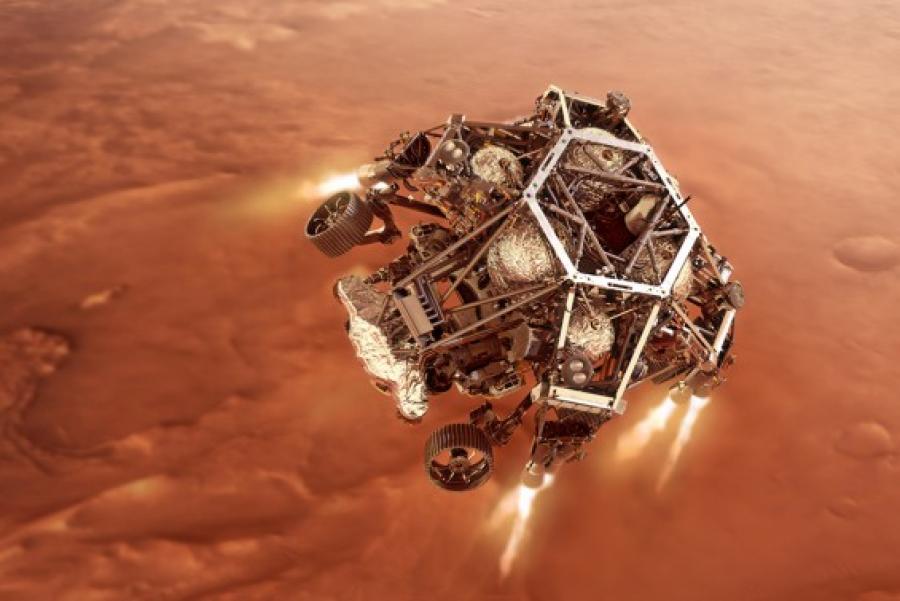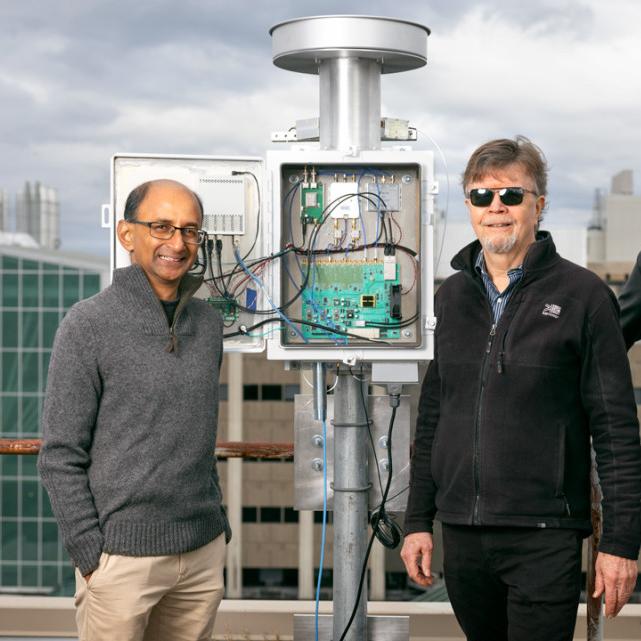With under a million miles yet to travel and days to go, the Mars 2020 mission’s Perseverance craft zips smoothly through space at 48,000 mph on the last leg of an eight-month, 300-million-mile journey to our neighboring red planet.
The spacecraft remains ready, healthy and raring to rove, according to NASA and the Jet Propulsion Laboratory (JPL).
On Feb. 18, Perseverance will enter the top of the Martian atmosphere, where it will endure high temperatures and a 7-minute harrowing ride, before it lands gently at Jezero Crater.
Join Cornellians online for the Mars 2020 Landing Live Watch Party, hosted by Cornell’s Spacecraft Planetary Imaging Facility and Cornell’s Carl Sagan Institute, Feb. 18 from 2:30 to 4:30 p.m. The Perseverance landing sequence begins at 3:45 p.m. EST, with touchdown expected at 3:53 p.m.
Cornell researchers have spent the eight months since launch preparing for this day.
Alex Hayes ’03, M.Eng. ’03, associate professor of astronomy in the College of Arts and Sciences, is a co-investigator on Mastcam-Z, the rover’s zoomable, mast-mounted camera system. He and his team have been finalizing the Mastcam-Z radiometric calibration pipeline, ensuring the cameras are ready to operate upon landing.
“We’ve been in training for operations, running mock missions using the rover’s engineering model at the Jet Propulsion Laboratory,” Hayes said, “to iron out the kinks for all the remote operational roles.”
Some instrument calibration activities must wait until landing, as the “Martian environment is very hard to recreate in the lab,” he said. “One of the first things the team will do after landing is acquire data to validate and update the pre-launch instrument calibrations.”
Accompanying Perseverance will be Ingenuity, a small helicopter stowed away in the rover’s underbelly. The spacecraft will land at Jezero crater, an ancient lake basin at the end of a multibillion-year-old river network. While examining the ancient river delta and its surroundings, the rover’s sample and caching system will collect soil and rock types, and prepare them for a follow-up mission that will return samples to Earth.
The Perseverance rover is the first of three major mission steps. “Our job is to land at Jezero, identify the environment, provide context and cache the samples that will eventually be brought back to Earth,” Hayes said. “This is really the start of a much larger endeavor. It’s more than just a single mission, it’s the start of a campaign.”
The European Space Agency’s (ESA) Sample Fetch Rover will land at Jezero in August 2028 to retrieve the vials, which will be placed in a NASA-designed Mars-ascent vehicle and launched into Martian orbit. A third mission will retrieve the samples from Martian orbit and ferry them to Earth for study. The ESA-built Earth-return orbiter – together with NASA’s Earth-entry vehicle – will deliver the samples to Earth in spring 2032.
Jim Bell, an astronomy professor at Arizona State University and adjunct professor of astronomy (A&S) at Cornell, is principal investigator for Perseverance’s Mastcam-Z. While at Cornell, he served as the principal investigator for the panoramic camera, or PanCam, on the Spirit and Opportunity rovers.
Cornellians joining Hayes on the Mastcam-Z team will be co-investigator Rob Sullivan, a senior research associate (A&S); doctoral students Megan Barrington, in Earth and Atmospheric Sciences in the College of Agriculture and Life Sciences, and Christian Tate, astronomy; and Paul Corlies, Ph.D. ’19, who helped calibrate the Mastcam-Z’s stereoscopic and multispectral camera.
Co-investigator Don Banfield, a principal research scientist at Cornell (A&S), works on the Mars Environmental Dynamics Analyzer (MEDA) – an instrument that measures wind speed, temperature, humidity and the size of dust particles in the Martian atmosphere. Banfield is also a long-term planner, one of the co-investigators tapped to lead the group that determined the rover’s exploration strategy after landing. Sullivan is also a member of the MEDA team.
Mike Mellon, principal research scientist at Cornell (A&S), is a co-investigator on the Radar Imager for Mars’ Subsurface Experiment (RIMFAX), which will be used to probe below the Martian surface. Radar images will provide context for the sampled rocky outcrops and give a unique view of the region’s buried geological history.







